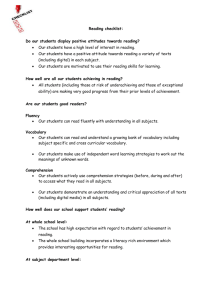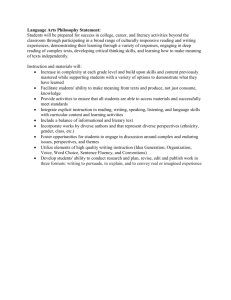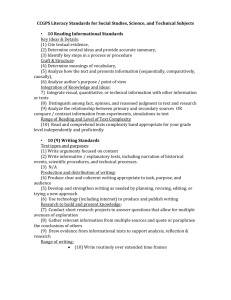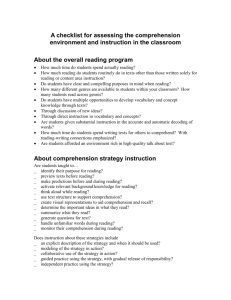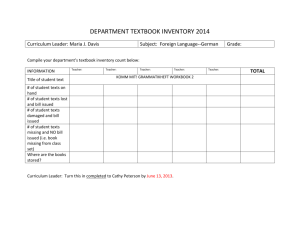1 - Michigan's Mission: Literacy
advertisement
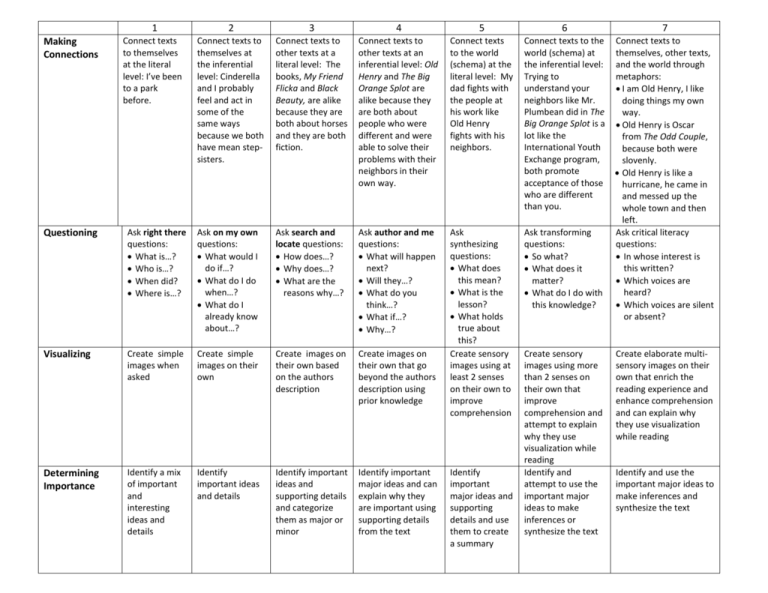
Making Connections 1 2 3 4 5 6 7 Connect texts to themselves at the literal level: I’ve been to a park before. Connect texts to themselves at the inferential level: Cinderella and I probably feel and act in some of the same ways because we both have mean stepsisters. Connect texts to other texts at a literal level: The books, My Friend Flicka and Black Beauty, are alike because they are both about horses and they are both fiction. Connect texts to other texts at an inferential level: Old Henry and The Big Orange Splot are alike because they are both about people who were different and were able to solve their problems with their neighbors in their own way. Connect texts to the world (schema) at the literal level: My dad fights with the people at his work like Old Henry fights with his neighbors. Connect texts to the world (schema) at the inferential level: Trying to understand your neighbors like Mr. Plumbean did in The Big Orange Splot is a lot like the International Youth Exchange program, both promote acceptance of those who are different than you. Ask synthesizing questions: What does this mean? What is the lesson? What holds true about this? Create sensory images using at least 2 senses on their own to improve comprehension Ask transforming questions: So what? What does it matter? What do I do with this knowledge? Connect texts to themselves, other texts, and the world through metaphors: I am Old Henry, I like doing things my own way. Old Henry is Oscar from The Odd Couple, because both were slovenly. Old Henry is like a hurricane, he came in and messed up the whole town and then left. Ask critical literacy questions: In whose interest is this written? Which voices are heard? Which voices are silent or absent? Questioning Ask right there questions: What is…? Who is…? When did? Where is…? Ask on my own questions: What would I do if…? What do I do when…? What do I already know about…? Ask search and locate questions: How does…? Why does…? What are the reasons why…? Ask author and me questions: What will happen next? Will they…? What do you think…? What if…? Why…? Visualizing Create simple images when asked Create simple images on their own Create images on their own based on the authors description Create images on their own that go beyond the authors description using prior knowledge Determining Importance Identify a mix of important and interesting ideas and details Identify important ideas and details Identify important ideas and supporting details and categorize them as major or minor Identify important major ideas and can explain why they are important using supporting details from the text Identify important major ideas and supporting details and use them to create a summary Create sensory images using more than 2 senses on their own that improve comprehension and attempt to explain why they use visualization while reading Identify and attempt to use the important major ideas to make inferences or synthesize the text Create elaborate multisensory images on their own that enrich the reading experience and enhance comprehension and can explain why they use visualization while reading Identify and use the important major ideas to make inferences and synthesize the text Inferring Make simple predictions based on information from the cover and title of the text Synthesizing Create a summary with help: Simple retelling Book report Monitoring Comprehension Monitor when attention is drawn to errors Make elaborate predictions based on information from the cover, title, and illustrations of the text Create an elaborated summary with help: Simple retelling with lesson learned Book report that states lesson learned Make elaborate predictions based on the information contained in the written text and justify their predictions Create an elaborated summary on their own Make inferences (differ from predictions in that the reader may never know if the inference is correct or not) based on the texts Create an elaborated summary on their own in a creative form: Poster Headlines Skit Make inferences based on the texts and answer the question: How do you know? Self monitor word level errors Self correct word level errors Self monitor break down in comprehension Self correct break down in comprehension Create something new: A different ending Same story different genre Fracture a fairytale Attempt to draw conclusions, state themes, or create theories about texts, the conclusions, themes, and theories are generic Create generative knowledge by creating or delineating: principles theories lessons learned alternative solutions new dilemmas Draw conclusions, state themes, or create theories about texts, the conclusions, themes, and theories are relevant or unique to the text Use many but not all of the comprehension strategies to correct break down in comprehension Integrate all of the comprehension strategies to analyze text, synthesize text, and use the knowledge gained from text to transform the way they think, act, or believe Create a narrative designed to change the thoughts, feelings, and behaviors of others based on the generative knowledge gained from the text

